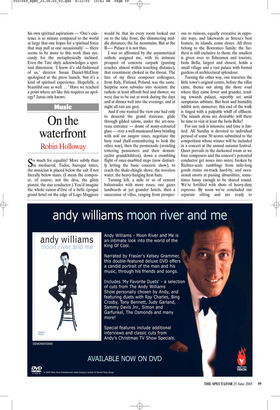Exhibitions 2
Spiritual dimension
Laura Gascoigne
Paul Feiler: The Near and The Far Tate St Ives, until 25 September The human eye is an amazing mechanism, but its vision is limited. We can’t see behind us, we can’t see much to the side, and in front — unless we’re desert tribesmen or Eskimos — our view is almost always obstructed by something. So some of what we see is actually ‘seen’, the rest is extrapolated from experience. Plus, our view from any one point — between those rocks, beyond that gateway, through those trees — exists only in that one spot at that one time. Move forward, back, to the side and it changes; wait for the light to alter and it’s further transformed.
These are not questions that bother most of us as we hurtle blindly from one view to another, but they bother painters whose professional business is to extrapolate 2-D imagery from visual experience. They have occupied Paul Feiler all his working life, and he has formulated some intriguing answers.
As a young abstract painter in Cornwall in the 1950s, Feiler wrestled with the pictorial problems posed by Homo erectus’s paradoxical habit of standing vertically while scanning horizontally. His first solutions were gestural abstractions in which elements of the landscape — cliffs, tree trunks, boulders — floated in a creamy space while apparently still attached to the ground. Then a science writer showed him a little girder he had picked up on the Apollo II launch site, and asked him to paint a picture of the moon. So began a series of explorations of space with a capital ‘S’ that led Feiler to the pure geometric abstractions which form the climax of his mini-retrospective, The Near and The Far, at Tate St Ives and the subject of his recent show, Janicon, at the Redfern Gallery.
Born in Germany in 1918 but trained at the Slade, Feiler was never your typical ‘St Ives’ painter, though after settling in Penzance in 1953 he made a good fist of looking like one. His early oils, with their thick earthy colours applied with a certain expressionist machismo, clearly relate to the work of Peter Lanyon and Bryan Wynter. Yet there’s something rather un-English about their modernism, too muscular for Ben Nicholson but not quite gestural enough for the next generation. By the 1960s, his compositions of circles and rusty bars bent into near-90 degree angles seem to be reaching beyond the landscape towards pure abstraction. As he himself says, ‘I couldn’t become a ventriloquist and try to become someone else just to become a member of the scene. Gradually, I withdrew from the scene and did my own thing.’ His own thing, when it took shape, had more in common with the geometric colour investigations of Josef Albers and Ad Reinhardt than with the earthbound post-war modernism of St Ives. For a start, he turned his focus from outdoors in. The three series of square canvases — ‘Ambit’, ‘Aduton’ and ‘Janicon’ — which have absorbed him for the past three decades take inspiration from the idea of an inner sanctum. Their reference to classical temples is obvious not just from their titles, but also from their lines of steps and columns framing an inner chamber sometimes containing a mysterious disc. Their muted colours, ranging from misty blues through greenish-greys to corn golds, warm rusts, dusky browns and blacks, are applied in glazes, subtly eliding the transition from one to the next. The resulting harmonies are so close that your eyes need time to adjust, as if stepping from daylight into the rich gloom of a shrine.
In the first two series the shades of colour tend to lead inwards, but the ‘Janicon’ pictures — combining ‘Janus’ and ‘icon’ — are more complex. ‘Forwards, not back’ is too simplistic a concept for the classical god of doorways, who looks both ways. With these paintings we’re no longer sure if we’re coming or going, but two steps forward, one step back still feels like progress, while the final goal remains in sight. In the newest work, areas of gessoed relief add a rogue element of reality to the optical illusion, while the introduction of gold and silver leaf, overlaid with glowing veils of pigment, lends a Byzantine richness to the colour. As you move around them, the pictures change.
Feiler has always been a consummate craftsman, but is this new work merely gilding the modernist lily? When I last saw Gallery 5 at Tate St Ives, it was a rumpus room for the noisy paintings of Terry Frost; now Feiler’s late paintings fill it with a meditative hum. Despite the modesty of his own spiritual aspirations — ‘One’s existence is so minute compared to the world at large that one hopes for a spiritual force that may pull at one occasionally’ — there seems to be more to this work than eyecandy for the metaphysically inclined. Even the Tate shyly acknowledges a spiritual dimension. ‘I know it’s old-fashioned of us,’ director Susan Daniel-McElroy apologised at the press launch, ‘but it’s a kind of spiritual experience. Hopefully, a beautiful one as well... ’ Have we reached a point where art like this requires an apology? Janus only knows.



































































 Previous page
Previous page